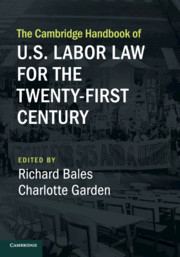Book contents
- Advance Praise for The Cambridge Handbook of U.S. Labor Law for the Twenty-First Century
- The Cambridge Handbook of U.S. Labor Law for the Twenty-First Century
- The Cambridge Handbook of U.S. Labor Law for the Twenty-First Century
- Copyright page
- Contents
- Contributors
- Preface
- Acknowledgments
- Part I Introduction
- Part II Labor Law Is Out of Date
- 3 Yesterday’s Labor Law and Today’s Challenges
- 4 The National Labor Relations Board in the Twenty-First Century
- 5 Beyond the Race to the Bottom
- 6 Union Rights for All
- 7 Public Sector Innovations
- 8 Combatting Union Monopoly Power
- 9 The Case for Repealing the Firm Exemption to Antitrust
- 10 Make Labor Organizing a Civil Right
- Part III The “Fissured” Workplace
- Part IV Barriers to Forming a Collective Bargaining Relationship
- Part V Barriers to Bargaining a Good Contract
- Part VI Unions, Civil Society, and Culture
8 - Combatting Union Monopoly Power
The Contrast Between Pre- and Post-New Deal Legal Regimes
from Part II - Labor Law Is Out of Date
Published online by Cambridge University Press: 01 November 2019
- Advance Praise for The Cambridge Handbook of U.S. Labor Law for the Twenty-First Century
- The Cambridge Handbook of U.S. Labor Law for the Twenty-First Century
- The Cambridge Handbook of U.S. Labor Law for the Twenty-First Century
- Copyright page
- Contents
- Contributors
- Preface
- Acknowledgments
- Part I Introduction
- Part II Labor Law Is Out of Date
- 3 Yesterday’s Labor Law and Today’s Challenges
- 4 The National Labor Relations Board in the Twenty-First Century
- 5 Beyond the Race to the Bottom
- 6 Union Rights for All
- 7 Public Sector Innovations
- 8 Combatting Union Monopoly Power
- 9 The Case for Repealing the Firm Exemption to Antitrust
- 10 Make Labor Organizing a Civil Right
- Part III The “Fissured” Workplace
- Part IV Barriers to Forming a Collective Bargaining Relationship
- Part V Barriers to Bargaining a Good Contract
- Part VI Unions, Civil Society, and Culture
Summary
The status of unions in the United States has been a source of constant political strife for the past 125 years. The differences in worldviews are not matters of small detail, but of fundamental design. It is important, therefore, to set out in rough historical fashion the evolution of the legal responses to union power. To most of the authors in this volume, the emphatic rejection of the common-law rules that once regulated management-union relations ranks as one of the unalloyed achievements of the New Deal era, which in rapid succession passed the Norris-LaGuardia Act of 1932 (an act signed by President Herbert Hoover, and sponsored by two progressive Republicans, Senator George Norris of Nebraska, and Representative Fiorello LaGuardia of New York) and the National Labor Relations Act of 1935. For many years I have strongly taken the opposite position. I think these two statutes represented a major backward step in labor relations, which was tempered only in part by the passage, in 1947, of the Taft–Hartley Act, which modified the NLRA.
- Type
- Chapter
- Information
- Publisher: Cambridge University PressPrint publication year: 2019
- 2
- Cited by



